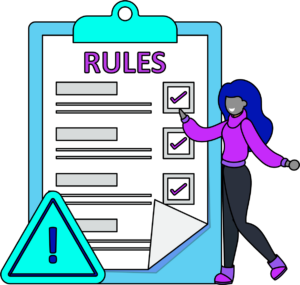Continuing education (CE) compliance is critical with respect to maintaining industry standards and professional development and, like any important aspect of running an organization, there are complexities to CE compliance that you must be aware of.
For instance, not only does every industry have its own governing bodies for continuing education credits, but some of those industries also vary by state.
To offer CME credit there is a lengthy process to become accredited. It is important to work with professionals who understand the ins-and-outs of CE compliance.

5 Reasons why CE compliance is important.
Of course, CE compliance doesn’t have to be overly complicated. That’s why our team has created this article, a guide on how to achieve compliance across your organization with confidence and ease.
1. Renewal of certifications and licenses.
Many certifications and licenses require periodic renewal. Accurate records of completed CE activities are typically required as part of the renewal process.
Without proper documentation, individuals may risk losing their credentials. This can stall professional progress and present a barrier to pursuing career opportunities.
Few people can afford this eventuality.
2. Regulatory and legal compliance.
We know that a variety of professions and industries have regulatory bodies or licensing authorities that mandate CE requirements and that those requirements can be further complicated by state-to-state discrepancies.
Accurate records help organizations and professionals adhere to these requirements and avoid potential legal issues or penalties for non-compliance.
3. Audits and verification.
Regulatory bodies or accrediting organizations may conduct audits to verify compliance.
Accurate records facilitate these audits by providing transparent and easily accessible documentation of completed CE activities.
4. Professional development.
Accurate records help professionals track their own progress and development over time.
This information can be used for personal growth, career advancement, and setting goals for continuous learning.
5. Enhanced reputation.
Organizations that consistently demonstrate compliance with CE requirements through accurate records build a reputation for professionalism, commitment to education, and industry expertise.
10 Challenges for getting to CE compliance.
Ensuring CE compliance can be challenging, especially for organizations and professionals who are required to meet ongoing educational requirements to maintain certifications, licenses, or qualifications.
Keeping track of completed CE activities and maintaining accurate documentation can be cumbersome, especially when dealing with a large number of employees or individuals.
Proper record-keeping is crucial to demonstrate compliance during audits or renewals. But who has the time?
Our team has tracked the following challenges commonly encountered by organizations as they try to ensure CE compliance (spoiler alert: it’s a pretty lengthy list!):
1. Variety of requirements.
Different professions, industries, and certifying bodies have varying CE requirements, including the number of hours, specific topics, and formats of education.
Managing and understanding these diverse requirements can be complex, especially when you consider that these requirements can also be geographically specific as some states have certain requirements and others don’t.
Keeping up with these nuances is time-consuming and subject to potentially costly errors.
2. Changing regulations.
In case the disparate CE requirements weren’t mind-boggling already, it turns out they can also evolve over time due to regulatory changes or advancements in the field.
Staying updated with the latest requirements and ensuring that the education being offered remains relevant can be a challenge and, again, a burden on finite resources, like time.
3. Quality of education.
Ensuring that the CE activities offered are of high quality, relevant, up-to-date and contribute meaningfully to the professional development of individuals can be difficult, especially in rapidly evolving fields where new information is constantly emerging.
The content and delivery methods should align with the needs of participants and the objectives of the CE program.
This requires careful monitoring and ongoing assessment, including soliciting specific feedback from participants.
4. Engagement and participation.
Encouraging individuals to actively participate in CE activities and complete the required hours can be a struggle.
Factors such as busy schedules, lack of motivation, and competing priorities can hinder engagement.
5. Verification and fraud prevention.
Verifying the authenticity of completed CE activities and preventing fraudulent submission of false education records is important to maintain the integrity of the CE program.
6. Administrative burden.
Organizations responsible for managing CE compliance may face administrative challenges in terms of organizing courses, coordinating registrations, tracking attendance, and managing the overall CE process.
7. Location logistics.
In organizations with employees or members located in different regions, ensuring equal access to CE opportunities and standardizing compliance procedures can be more complex.
8. Lack of technology and systems.
Without the right tools or by relying exclusively on manual processes, managing CE compliance efficiently can quickly become unorganized, chaotic, and prone to error.
9. Time and resource constraints.
Professionals and organizations may face constraints in terms of time and resources needed to participate in or offer CE activities.
This can be particularly challenging for small businesses or individuals with limited budgets.
10. Resistance to change.
Implementing new CE compliance processes or requirements might face resistance from employees, members, or stakeholders who are accustomed to existing practices.

9 strategies to ensure CE compliance.
Ensuring continuing education compliance across an organization is crucial for maintaining professional standards, meeting regulatory requirements, and fostering ongoing learning and development. Here are some strategies organizations can use to help ensure continuing education compliance:
1. Clear policies and procedures.
Develop and communicate clear policies and procedures regarding continuing education requirements.
Ensure that all employees understand these policies and the consequences of non-compliance.
Stay informed about industry or regulatory changes that may impact continuing education requirements.
Update your organization’s policies and procedures accordingly.
2. Centralized auditing, tracking and reporting:
Implement a centralized system for tracking and reporting continuing education credits.
Conduct regular audits and reviews of employees’ continuing education records to ensure compliance.
This system should capture completed courses, certifications, and other relevant information and include spot-checks and more comprehensive reviews around CE due dates.
Tip: Attendee Interactive provides a user portal where CE credits can be managed, as well as robust reporting.
3. Automated reminders.
Use technology to send automated reminders to employees about upcoming deadlines for continuing education requirements.
These reminders can help prevent last-minute scrambles to meet requirements.
4. Easy access to education and training with customized learning paths.
Provide easy access to training and education to employees about the importance of continuing education and compliance with organizational policies.
Offer resources and guidance on how to find relevant courses and opportunities like an online Learning Management Systems (LMS).
Implement an LMS that allows employees to access approved courses, track their progress, and access customized learning paths for different roles or departments within the organization.
Tailor continuing education requirements to align with specific job responsibilities.
Tip: Attendee Interactive can pair-up with Crowd Wisdom LMS for online learning to help you create a power-house for attaining CE Compliance across your organization.
5. Support for Continuing Education.
Offer support, such as financial assistance or paid time off, for employees pursuing continuing education.
This demonstrates the organization’s commitment to professional development.
6. Feedback mechanisms.
Establish feedback mechanisms that allow employees to provide input on the continuing education programs and resources offered by the organization.
Use this feedback to continually improve offerings.
Tip: Great Continuing Education software, like Attendee Interactive, includes surveys and course evaluations that can be collected from attendees and used year-after-year to continuously improve your Continuing Education programs.
7. Incentives and recognition.
Consider offering incentives or recognition for employees who consistently meet or exceed continuing education requirements.
Gift cards are great in our new, more remote work environment.
Depending on your budget, this can range from $10 Starbucks gift cards to $100 Amazon gift cards.
If you have a famous speaker at your continuing education conference, you could enter attendees in a raffle for a meet-and-greet opportunity to encourage attendance.
Or simple recognition goes a long way.
Thank the individuals who complete the requirements early.
People love rewards and can motivate individuals to stay compliant.
8. Consequences for non-compliance:
Some professional licenses can be suspended for non-compliance.
Clearly communicate the consequences of non-compliance with continuing education requirements, which may include disciplinary actions or limitations on job responsibilities.
Consequences help organizations create a culture of compliance and ongoing learning, ensuring that employees remain up-to-date and qualified in their respective fields.
9. Leverage Continuing Education Management Software
Particularly in the service of accurate record-keeping and consistent monitoring, Continuing Education Management Software can contribute to successful CE compliance.
Organizations can invest in robust CE management systems to provide clear communication about requirements and benefits, offer diverse and engaging education options, and establish a culture of continuous learning.
8 Benefits of Specialized Compliance Software.
Even the most cursory glance at the above list of CE compliance challenges could — and should! — inspire feelings of overwhelm.
That’s where compliance software comes in to save the day and lighten the load of managing all of these tasks and processes.
The advantages of using software to manage CE compliance are unmistakable, especially when it comes to record-keeping, tracking, and reporting.
1. Simplified Attendee Participation Tracking for CE compliance.
Time spent on manually tracking participants is quickly becoming a thing of the past, thanks to compliance software solutions that streamline participant tracking of CE activities.
What is the benefit of accurate attendance and participation records relative to CE compliance?
By leveraging the capabilities of compliance software, your organization will benefit from accurate attendance and participation records, which, in turn, provides the following.
2. Evidence of compliance.
Accurate records provide concrete evidence that individuals have completed the required CE activities.
This documentation is crucial during audits or renewal processes to demonstrate that the necessary education has been undertaken.
More on that later…
3. Quality assurance.
Keeping track of participation and attendance ensures that individuals are engaging with high-quality educational activities.
This quality assurance benefits both professionals seeking relevant education and organizations striving to provide valuable learning opportunities.
4. Individual and organizational accountability.
Detailed records hold individuals and organizations accountable for meeting CE requirements.
This accountability fosters a commitment to ongoing learning and staying up to date with industry trends.
5. Customized learning plans.
With accurate records, organizations can better tailor CE offerings to the specific needs and interests of participants.
This promotes more effective and relevant learning experiences.
6. Efficient resource allocation.
Organizations can analyze attendance and participation data to understand which topics or formats are most popular and effective.
This information enables more efficient allocation of resources for future CE activities.
7. Long-term planning.
Accurate records can help organizations plan their CE programs more effectively.
They can identify trends in attendance, preferences, and gaps in knowledge, enabling them to design future educational initiatives that better meet participants’ needs.
8. Accurate reporting.
Accurate records allow organizations to generate accurate reports for internal purposes or external reporting requirements.
This could include reporting to regulatory bodies, accreditation agencies, or stakeholders.
Compliance software streamlines the process of participant tracking to streamline certificate issuance. Since some CE credits require Board issuance reporting or License issuance reporting, putting the right processes in place should be a top priority.
Tip. Attendee Interactive saves you time by streamlining the evaluation, credit claiming, and certificate issuance all in one system. This results in accreditation compliance with enhanced tracking, reports, and centralized information for better accreditation management, overall.

9 Time-saving automated reporting and audit preparation.
Managing your organization can be made much easier by integrating automation where appropriate.
Reporting is one such task that is better left to software, rather than to risk human error. In the event of an audit, this automated reporting will prove invaluable.
Software-generated reports aid in preparing for audits and demonstrating compliance, thanks to the following.
1. Comprehensive documentation.
Software-generated reports provide a comprehensive overview of CE activities, including participant details, course descriptions, dates, hours, and completion statuses.
2. Efficiency.
Software can quickly compile and format data, making the audit preparation process more efficient.
This saves time compared to manually gathering and organizing information from different sources.
3. Configurable.
Many software systems allow you to customize report parameters, enabling you to generate reports tailored to specific audit requirements or organizational needs.
This flexibility ensures that the information presented is relevant and aligned with the audit scope.
4. Standardization.
Software-generated reports follow consistent formatting and presentation standards.
This uniformity makes it easier for auditors to review and compare information across different periods or participants.
5. Real-time access.
Some software systems offer real-time access to data, allowing auditors to review current compliance status and activities without delay.
This is particularly useful for remote audits or those that require up-to-the-minute information.
6. Audit trail.
Software often maintains an audit trail, showing changes made to records, user actions, and other relevant activities.
This level of transparency can enhance the credibility of the data presented during audits.
7. Exporting options.
Software-generated reports can often be exported in various formats (PDF, Excel, etc.), allowing you to provide auditors with easily shareable documents that align with their preferred format.
8. Automation.
Cutting-edge CE compliance software can automate the generation of reports based on predefined schedules.
This ensures that up-to-date reports are readily available whenever they are needed for audits or compliance reviews.
9. Secure storage.
Software systems typically offer secure data storage, protecting sensitive information from unauthorized access and maintaining the confidentiality of participant records.
Data insights that improve CE Compliance.
The right software platform will eliminate many of these time-consuming and tedious processes required by continuing education. Items like grading, certificate delivery, content production, and survey capabilities can all be automated to save you time and headaches, while providing your organization with actionable data insights such as.
Data accuracy.
The right software will capture and store data accurately.
This reduces the chances of manual errors that can occur when compiling information manually, ensuring that the information presented is reliable and trustworthy.
Historical data.
Software can also retain historical data, enabling you to demonstrate compliance over a specific period or multiple reporting periods.
This long-term record-keeping supports a broader view of compliance efforts and, in the event of an audit, demonstrates your commitment to compliance over time.
Data visualization.
Some software can present data in visual formats such as graphs, charts, or dashboards.
These visuals can provide a clear overview of compliance trends and patterns, making it easier for auditors to grasp key insights.
Search and filter capabilities.
Software-generated reports can be filtered and searched based on specific criteria.
This functionality makes it easier to locate and present information relevant to the audit scope.
Rather than rely on something like a guide to effective event session tracking and successful session management, smart organizations are increasingly implementing software solutions to ease the burden of these processes.

How to manage CE compliance for your organization.
If this article has proven anything, it’s that managing CE compliance for your organization is tedious, time-consuming, and an overwhelming process just to offer continuing education credits.
That’s why we’re here to help you out as we’ve helped many other higher education managers.
“I manage the logistics for a national conference, this year expecting 1000 attendees. This system manages our call for proposals, continuing education, and evaluations. It has cut about 150 work hours out of my schedule, allowing me to streamline attention, customer service, and my own mental health. The system has both reinforced existing and expanded infrastructure, allowing us to grow our conference program and attendance.”
— Jeffrey W., Senior Program Coordinator, Education Management
At Attendee Interactive, we have technological solutions that can help you manage the entire continuing education credit accreditation process on a single flexible platform.
Our platform is specifically designed to transform the way you handle the accreditation process.
By offering flexible solutions, support, and ease of use, we can carry the brunt of all the administrative work so you can focus on the things that need your attention the most.
With CE compliance software, you can skip all the chaos and concentrate on delivering an effective course.
Take your seat at the head of class with Attendee Interactive and conquer CE compliance with ease across your organization



